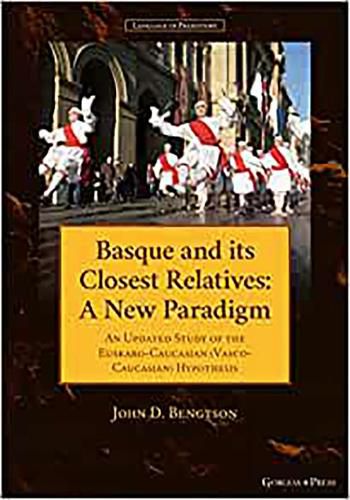Readings Newsletter
Become a Readings Member to make your shopping experience even easier.
Sign in or sign up for free!
You’re not far away from qualifying for FREE standard shipping within Australia
You’ve qualified for FREE standard shipping within Australia
The cart is loading…






This title is printed to order. This book may have been self-published. If so, we cannot guarantee the quality of the content. In the main most books will have gone through the editing process however some may not. We therefore suggest that you be aware of this before ordering this book. If in doubt check either the author or publisher’s details as we are unable to accept any returns unless they are faulty. Please contact us if you have any questions.
John D. Bengston offers a detailed analysis of the Euskaro-Caucasian hypothesis in this new volume, exploring the idea that the Basque language is most closely related to the North Caucasian language family. He builds on ideas proposed by prominent scholars in the 20th century, notably the work of C.C. Uhlenbeck, Georges Dumezil, and Rene Lafon. Whilst important, their ideas were rather sporadic and consisted of scattered articles, and they never developed a comprehensive phonological and morphological model of Euskaro-Caucasian. Now thanks to advances in our understanding of Basque phonology and etymology, and in North Caucasian phonology and etymology, and improved linguistic methods, it has become possible to develop a comprehensive Euskaro-Caucasian phonological structure, including regular sound correspondences of vowels and consonants supported by significant numbers of etymologies.
These correspondences, in turn, have allowed the author to evaluate objectively the etymological proposals of earlier investigators (which led to the modification or outright rejection of many of them), and have also provided clues to discovering some original etymologies. The nucleus of the Euskaro-Caucasian hypothesis is ‘old’, beginning in the 19th century, but the ‘new paradigm’ alluded to in this volume’s subtitle refers to a focus on the North Caucasian language family as the closest surviving relative of Basque (as opposed to the ‘South Caucasian’ = Kartvelian family); a new and comprehensive scheme of comparative phonology; new discoveries in comparative morphology; and finally several hundred lexical and grammatical etymologies that supersede the more haphazard comparisons offered in earlier research.
$9.00 standard shipping within Australia
FREE standard shipping within Australia for orders over $100.00
Express & International shipping calculated at checkout
This title is printed to order. This book may have been self-published. If so, we cannot guarantee the quality of the content. In the main most books will have gone through the editing process however some may not. We therefore suggest that you be aware of this before ordering this book. If in doubt check either the author or publisher’s details as we are unable to accept any returns unless they are faulty. Please contact us if you have any questions.
John D. Bengston offers a detailed analysis of the Euskaro-Caucasian hypothesis in this new volume, exploring the idea that the Basque language is most closely related to the North Caucasian language family. He builds on ideas proposed by prominent scholars in the 20th century, notably the work of C.C. Uhlenbeck, Georges Dumezil, and Rene Lafon. Whilst important, their ideas were rather sporadic and consisted of scattered articles, and they never developed a comprehensive phonological and morphological model of Euskaro-Caucasian. Now thanks to advances in our understanding of Basque phonology and etymology, and in North Caucasian phonology and etymology, and improved linguistic methods, it has become possible to develop a comprehensive Euskaro-Caucasian phonological structure, including regular sound correspondences of vowels and consonants supported by significant numbers of etymologies.
These correspondences, in turn, have allowed the author to evaluate objectively the etymological proposals of earlier investigators (which led to the modification or outright rejection of many of them), and have also provided clues to discovering some original etymologies. The nucleus of the Euskaro-Caucasian hypothesis is ‘old’, beginning in the 19th century, but the ‘new paradigm’ alluded to in this volume’s subtitle refers to a focus on the North Caucasian language family as the closest surviving relative of Basque (as opposed to the ‘South Caucasian’ = Kartvelian family); a new and comprehensive scheme of comparative phonology; new discoveries in comparative morphology; and finally several hundred lexical and grammatical etymologies that supersede the more haphazard comparisons offered in earlier research.